Generato non creato is a generative art work that consists of an endless variation of images created from a few simple elements, illustrated below.
16 meshes
+ 9 images

+ 17 code files

=
See it in action here.
Generato non creato is a generative art work that consists of an endless variation of images created from a few simple elements, illustrated below.


See it in action here.

Generato non creato is my first generative art piece. You can mint it on fx(hash). It’s a complex algorithm programmed in p5.js that creates images composed of several elements arranged in a circular symmetrical fashion inspired by monstrances. What follows is a dissection of the different parts that may or may not be present in any particular instance.
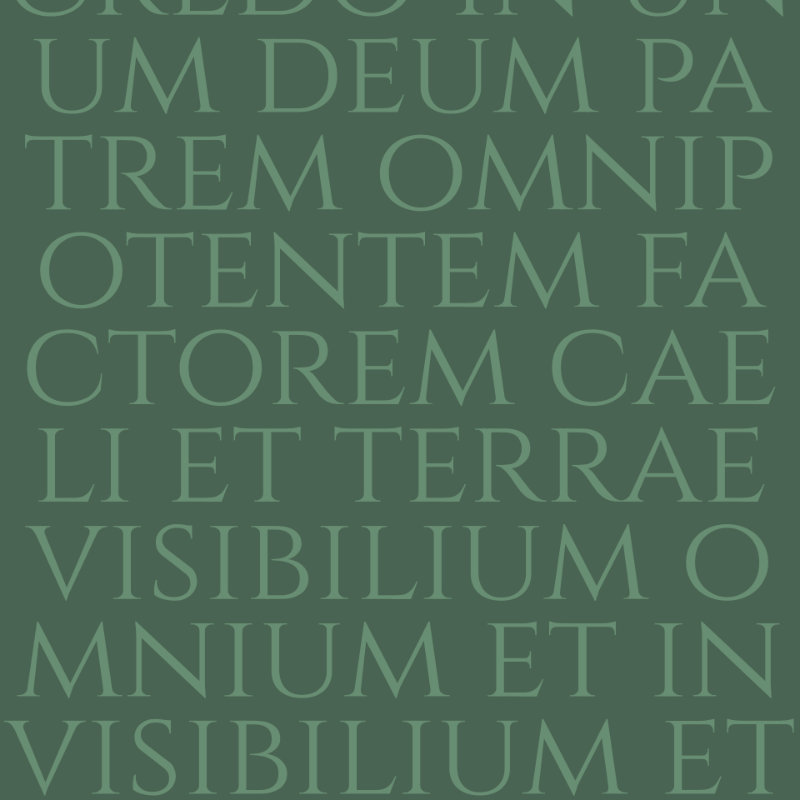
We start with the Nicene Creed from which the title is derived. We chose to use the Italian phrase because of the word “generato” which is a translation of the Latin “genitum”. The algorithm selects a random piece from the full Latin text and adapts the font size in order to fill the entire square.
The creed is a profession of faith that is 1700 years old. We say it at Holy Mass every Sunday. In it we declare to believe in God the father, creator of the universe, Jesus Christ, savior of Humankind and in the Holy Spirit, the giver of life. The prayer insists on the generation of Jesus Christ, as opposed to the creation of everything else: the son and the father are one.
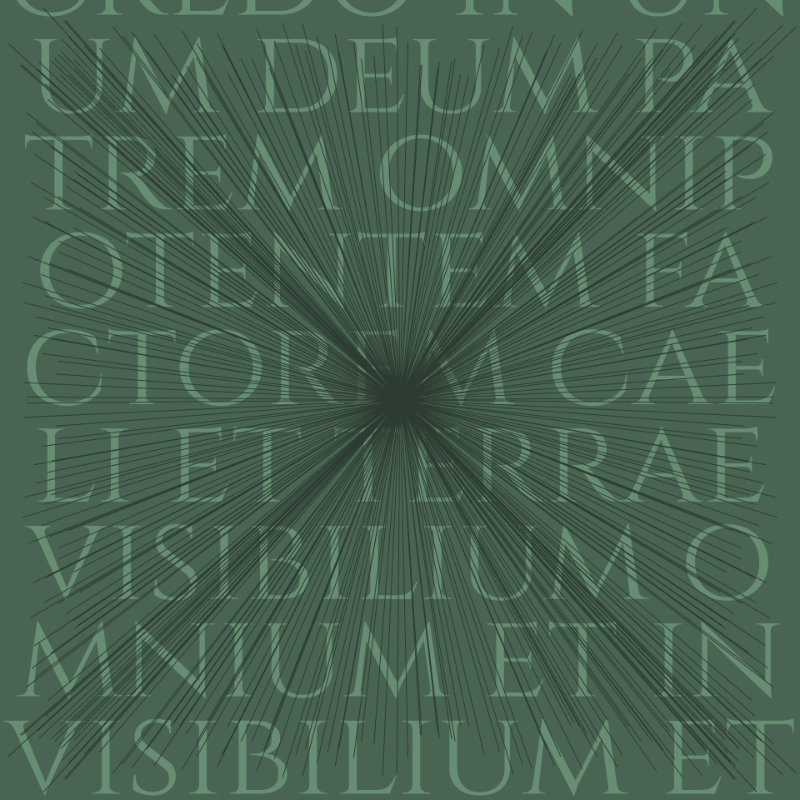
The project started with lines drawn on a 2D canvas. I spent an inordinate amount of time creating an algorithm that would allow for the center of the rays to be anywhere within the square. Only to decide later to keep it in the center always.

I switched to a 3D canvas in order to use lights. But I couldn’t figure out how to tweak the lights in p5.js for the effect that I wanted. So I used a bitmap to add shadows all around.
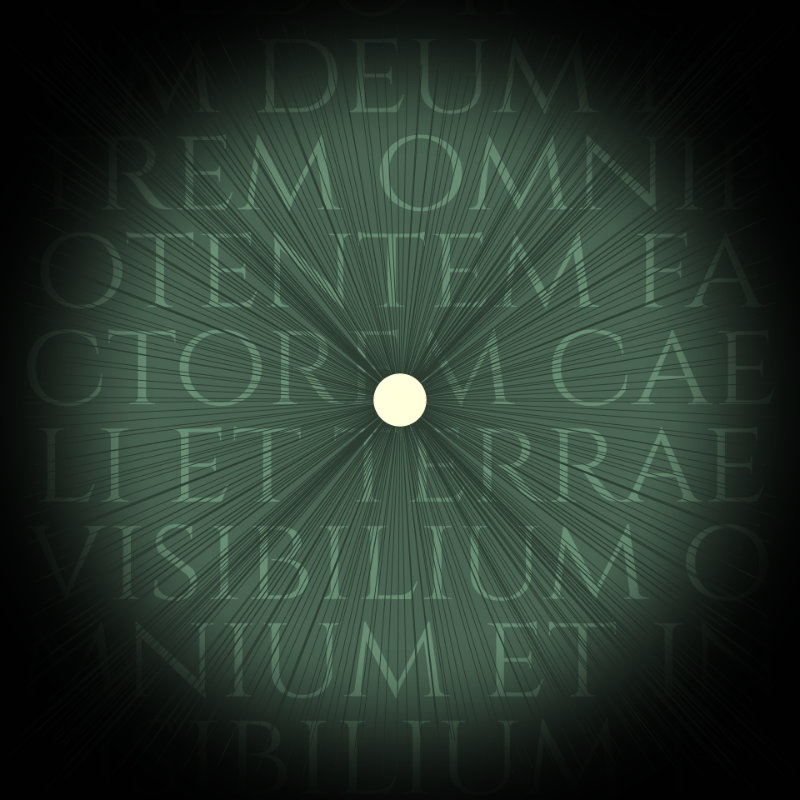
To be honest, initially I hadn’t imagined that there would be a Holy Host in the middle of the piece at all times. I had many ideas. But the Eucharist was the one that stuck, however. As a Catholic, I believe Jesus when He says that bread becomes His body during the liturgy. And I love to spend time with Him in Eucharistic Adoration.
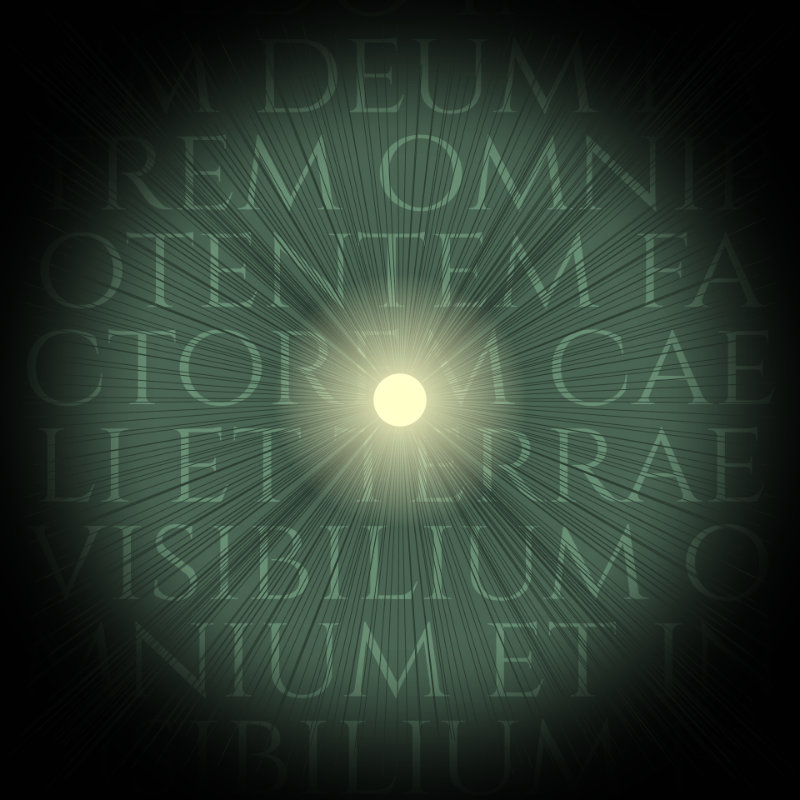
To express the holiness of the sacramental bread I added a halo. Again this was done with a bitmap and not with actual lights.

No 3D world of ours is complete without airborne particles. In this case they emanate from the center, confirming the general centrifugal thrust of the design, like light and love and grace and joy coming from the source of the world. The generative animation is a simple way to remind the viewer that they are looking at a realtime event, not just an image.
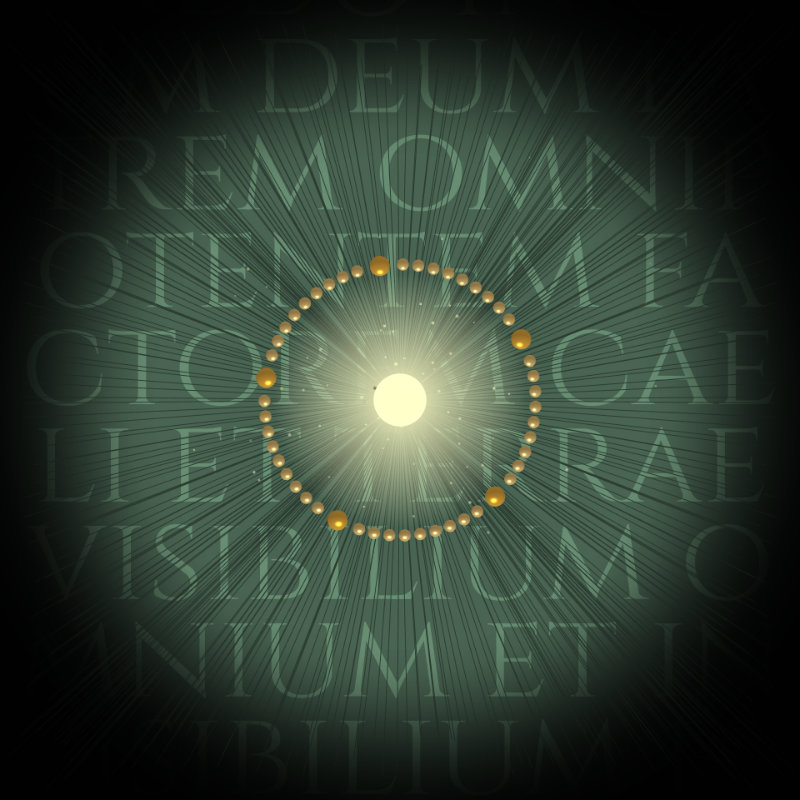
To surround the son with maternal love, I added a rosary, which is a string of 55 beads, 5 big ones to pray the Lord’s Prayer and 50 small ones to pray the Hail Mary prayer. With each decade we meditate on one of the mysteries of Christ’s life. There’s 4 groups of mysteries: Sorrowful, Joyful, Glorious, and Luminous mysteries. In the last decade of the latter, we contemplate the institution of the Eucharist.
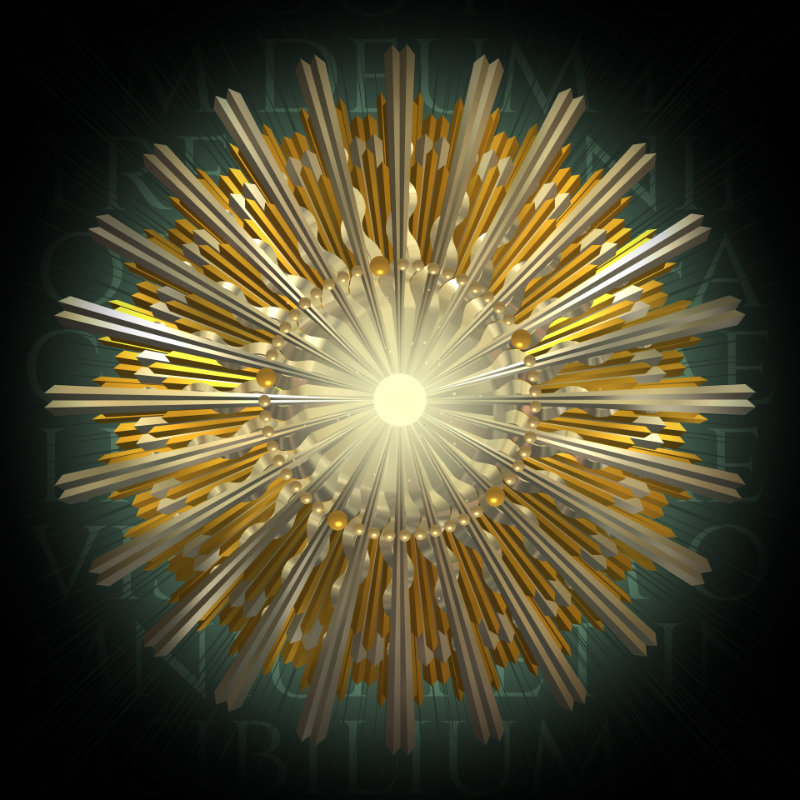
Then we start building the rays of glory. The first layer is composed of straight rays and wavy ones. The algorithm picks a number that allows for symmetry (4, 6, 8, etc), then divides the circle into that many parts, creates half of such a part with growing elements, mirrors that part and then duplicates the result while rotating until the circle is full, adding some randomness to number, type (straight or wavy), color (gold or silver), width and length for variation.
These are the first 3D elements and as such they are lit. The color of the light is derived from the color of the background. The reflective effect is caused by an environment map.
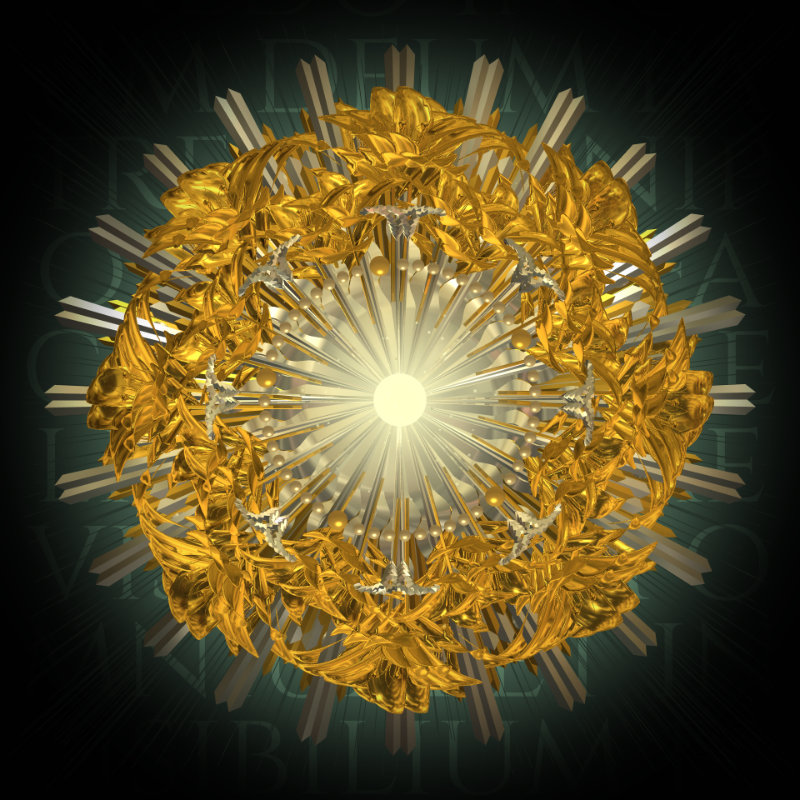
Then we use the exact same algorithm but with different 3D models: a lily flower and an ear of wheat, the first symbolizing purity and chastity, and the second fertility and abundance. Since especially the flower is a complex shape, combinations of many can produce unexpectedly rich results.
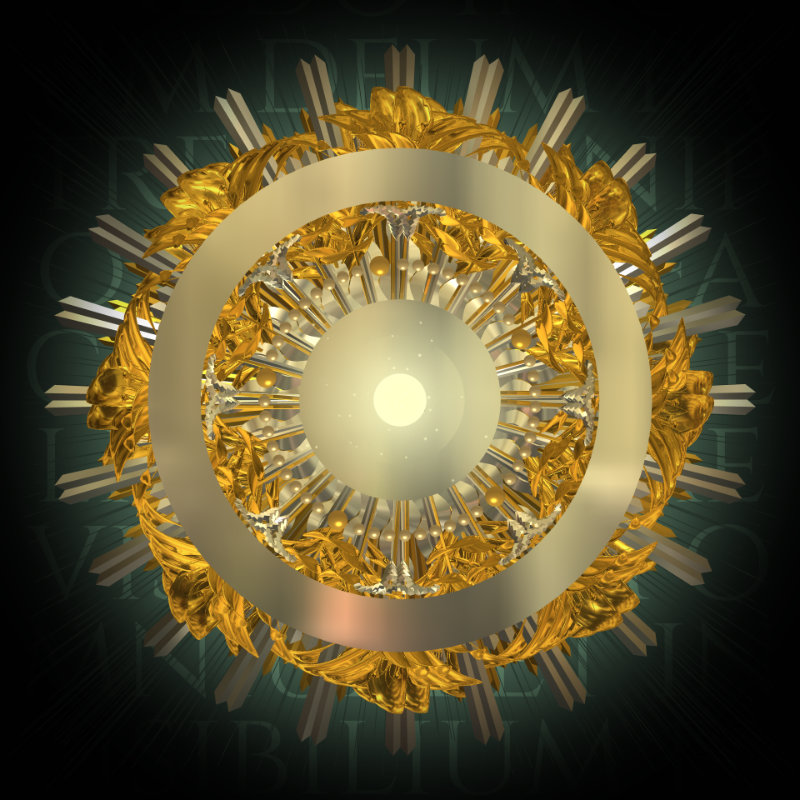
The discs are the only 3D elements that are generated by code and not based on a 3D model created by Auriea. This was necessary to make sure that they did not overlap but instead remained perfectly concentric. Again number, radius, width and color are randomized.
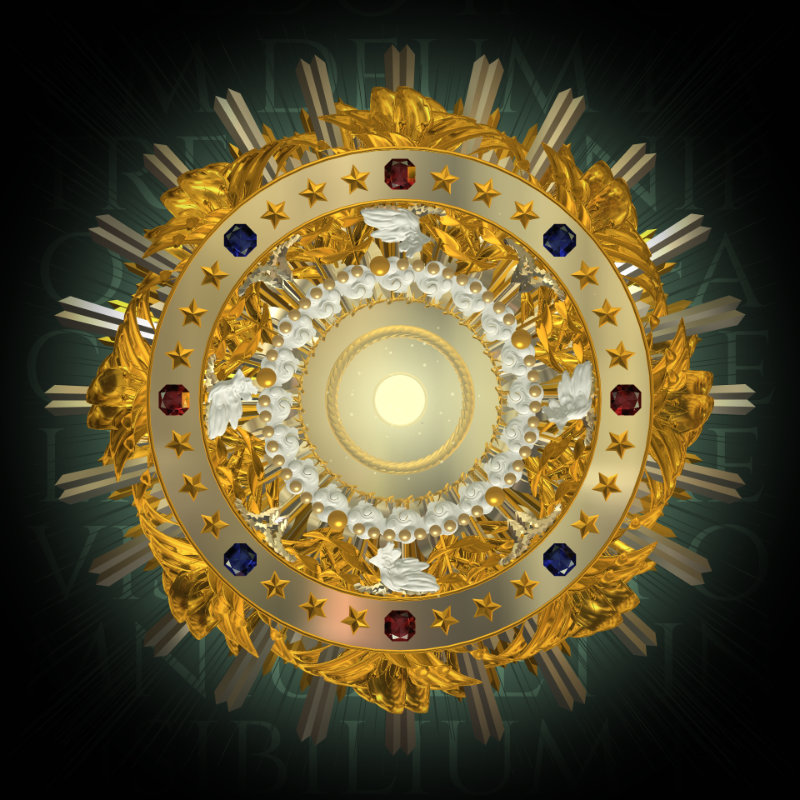
Taking the positions of the discs, ornaments are added such as gems (red, green or blue), stars (with 5 or 6 points), domes, clouds and wings. The latter two could be silver or gold but also white. These ornaments too are arranged in symmetrical repeating patterns, always affirming the horizontal, vertical and diagonal symmetry of the whole. With the exception of the wings, of which there can be three. Of some elements, the colors sometimes alternate (as in the gems in the image above).
At the edges of some discs a border is added, a simple torus or a ribbon made of smooth elements or thorns.
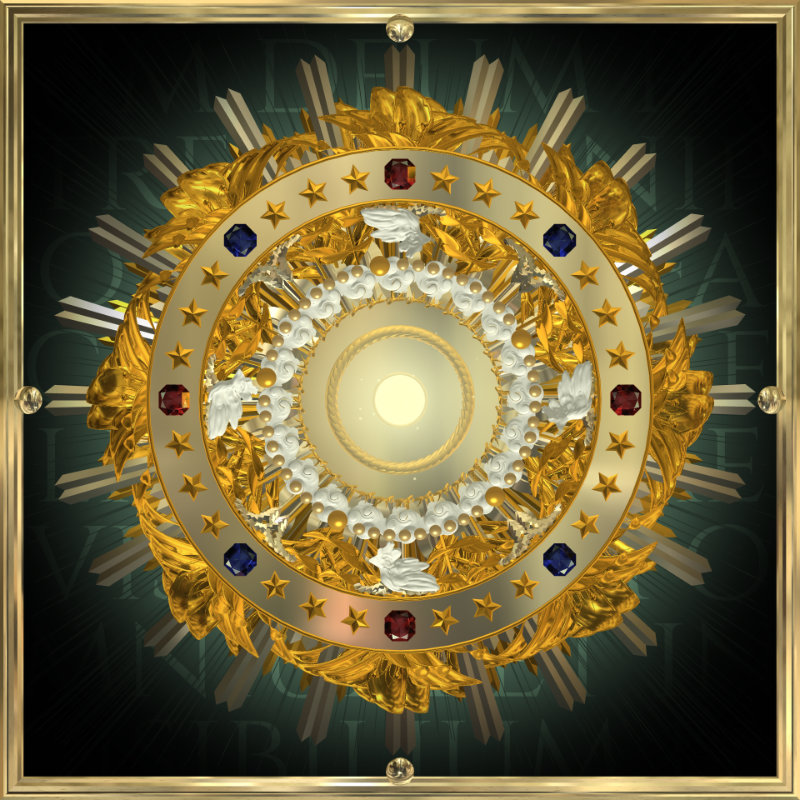
And as a finishing touch a frame is added, sometimes adorned with little spheres at the four cardinal points, to remind of the Cross. There’s also the possibility of a circular frame or a half circle (arc).
Please go and play with this for yourself on fx(hash): click “run” or “open” under the image. Drag to reveal the 3D composition and press the N key a new variation.
And please do mint an instance for yourself. This supports our work as well as research into Parkinson’s disease.
Thank you for reading.
Michael Samyn.
The process of building and packaging a multiplayer game in Unreal Engine is a complicated affair that involves hundreds of thousands of files stored on many gigabytes worth of hard disk space. Creating a single build can take hours. So errors are expensive. And with every new version of the engine new errors occur. So one can only half rely on past experience. It’s a huge challenge every time.
This time an additional problem occurred when the processor of our good old server machine turned out to be incompatible with the new game. So I decided to try a new server host for sharing this release.
Nevertheless I was very eager to share the work done in step 26. So, after fixing some remaining bugs and perfecting the Halloween features, I started the process that ultimately lead to beta 5 being available for your evaluation.
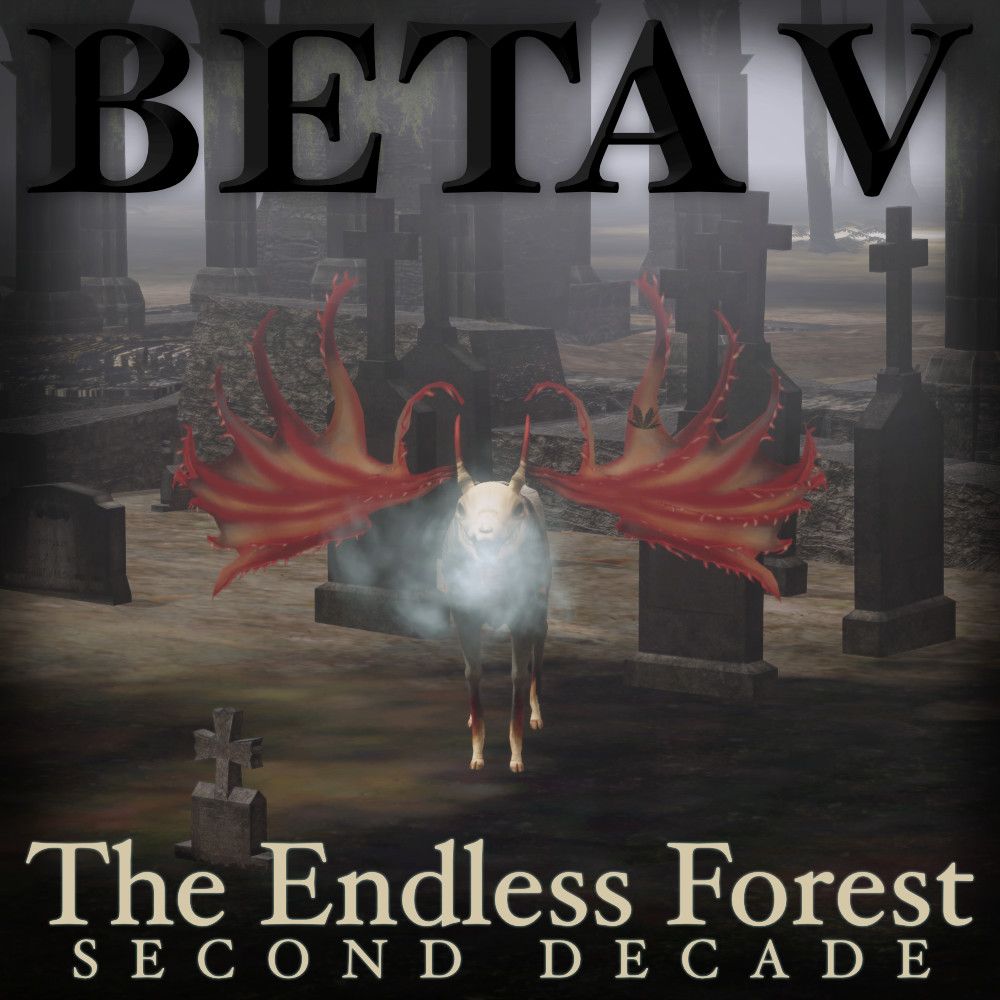
Download links have been emailed to supporters of the remake. I you would not have received yours, please contact us.
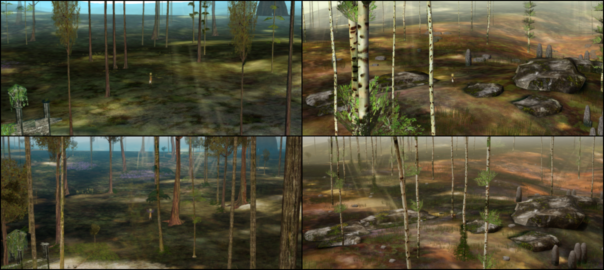
Motivated by bug reports and criticism of players following the release of beta 4, I started to tweak the remake of The Endless Forest so it would resemble the original game more. The two areas I focused on were controls and aesthetics. I’m happy with the changes I made to the controls but ran into a lot of trouble trying to make the game look in Unreal Engine the way it does in Quest3D. Part of the reason for this is that we painstakingly adapted the look of the game to the rather primitive rendering capacities of that old engine. In my frustration I decided to just make the game look good in Unreal and not worry about whether it resembled the original or not.
I started with the material used on the floor. Since the view of the game is top down most of the time, the floor has a great impact on the overall look of the game. I reused the textures from the original game but increased their resolution through an AI-driven process in an application called Topaz Gigapixel AI. I was quite impressed by the new detail in the high resolution textures. There’s textures for dirt, grass, light and shadows that were blended in a very specific way in Quest3D, unavailable in Unreal Engine. Instead of attempting to mimic that system, as I had before, I started over from scratch, with the same textures, but using blending methods specific to the new engine. I also added some relief and detail through normal maps generated by NormalMap Online based on the original textures.
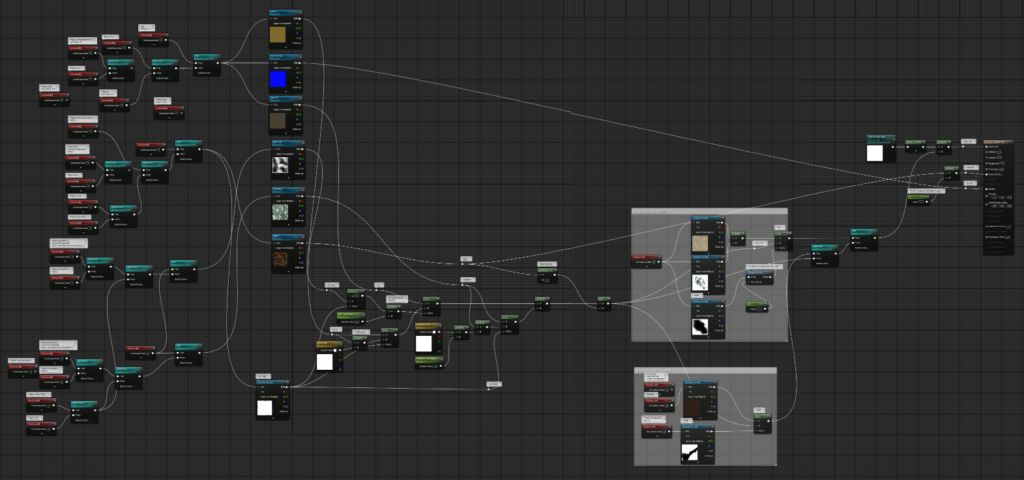
It took several days and several start-overs to get a result that I liked only to realize that now seams were visible between the tiles that make up the floor. I discovered these were not only caused by the uprezzing of the textures, but the new shader also made visible UV mapping errors that had not been visible before. So I corrected these in Blender.
In beta 4 the shadows were colored by three extra lights shining in the opposite direction of the sun light, imitating the natural effect of bouncing light. I replaced this by a Skylight element.
None of Unreal’s built-in methods for simulating fog was capable of hiding objects in the distance. As a result, geometry popped in abruptly when crossing forest borders. This was fixed by replacing the fog by a shader on a plane in front of the camera that colored objects based on distance. Sometimes primitive methods work better that attempts to simulate physical reality.
To complement the increased resolution of the floor textures, I also uprezzed the textures of the ruin, the playground, the watering hole and the trees and added generated normal maps.
The camera angle was also tweaked slightly to resemble the original game more. And the controls for walking, jumping and interacting with obstacles were also fine-tuned for smoothness.
The strange error of the swimming frog floating in the pond was also corrected.
I tweaked the shader of the tree foliage to become transparent when it is in front of the camera in order to have a better view on the deer.
At the end of this process the overall look of the game was actually similar to the original when I reduced the contrast in post processing. So I added a slider in the game’s options to change the contrast. Personally I think the goal of making The Endless Forest look better than the original has been achieved. But I will let you be the judge of that.
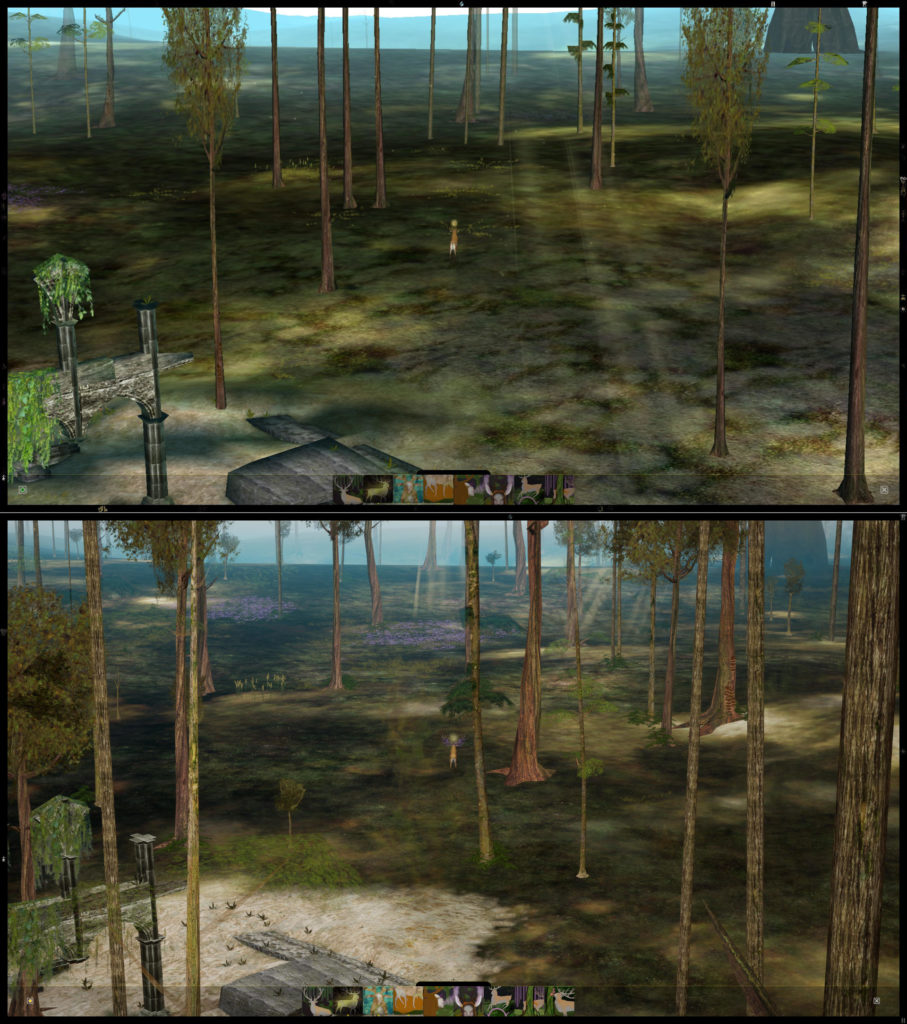
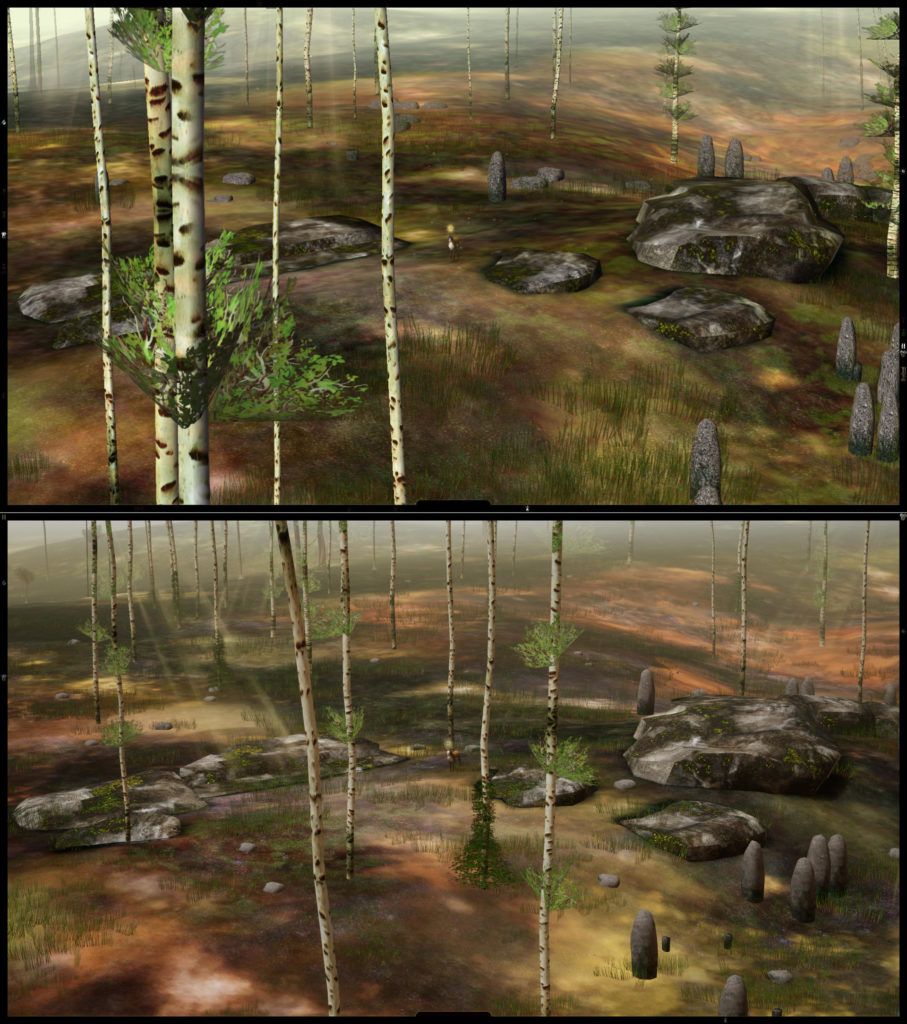
Note that trees and plants are placed in a very different way in the remake. Instead of the wonderful system available in Quest3D that allowed us to manually place threes and decor, I created a system in Unreal that places trees randomly within certain parameters. This is why they don’t appear in the same locations. The advantage of the new method, while we lose some of the deliberateness of the original, is that the forest can change in the future and that the density per area, similar to the original by default, can be increased by the player. The resolution of many textures was increased through AI but the 3D models remain the same as in the original.
I didn’t feel ready to release a new beta version because there’s still a number of bugs and issues I want to address first. And because I’m going on honeymoon.
Let me know what you think!
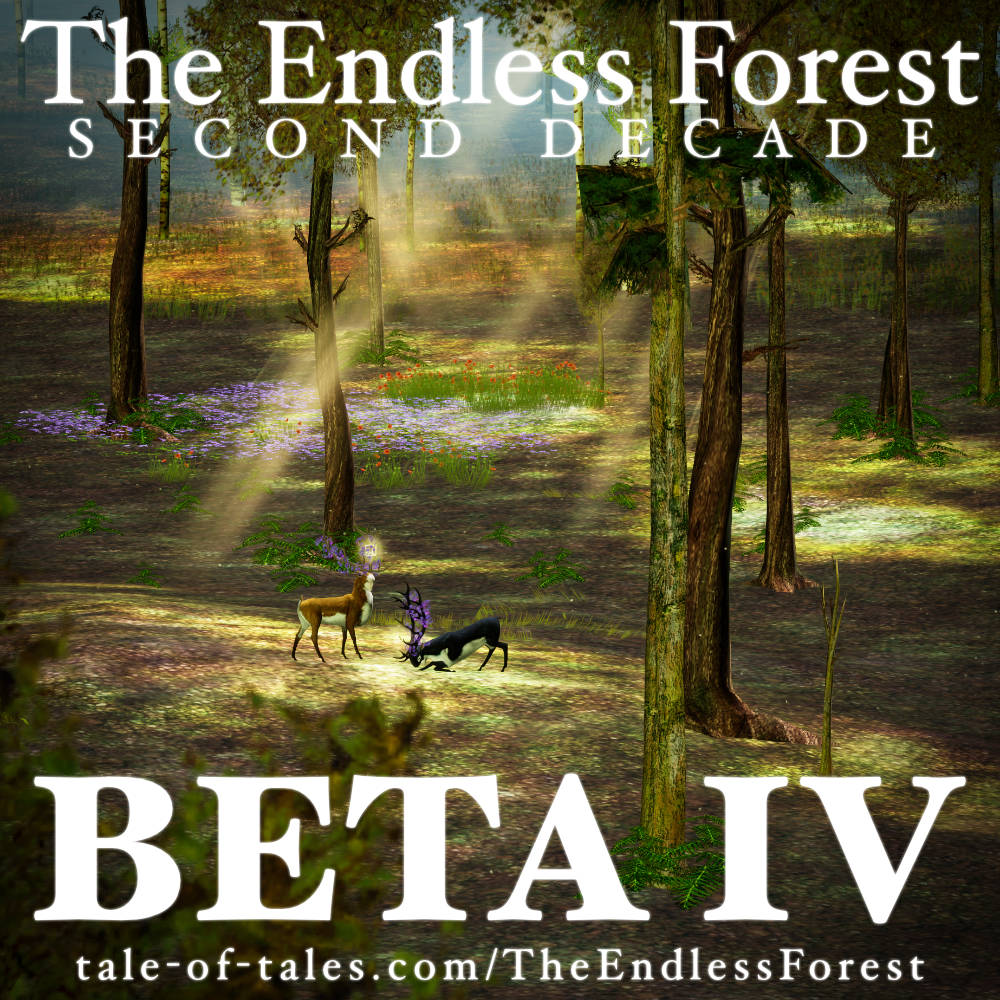
I was hoping to release this version to the public at large. It worked well and looked good on my computers. But to be on the safe side, I decided to release it to the community of players of the current game first. Just in case some minor issues needed tweaking before a public release.
Thanks to the diligent research of several Endless Forest players, a flood of bug reports rolled in, making it abundantly clear that this build, even for a beta release, is by no means ready for the public at large.
Many issues, sadly, seem to be related to performance. Apparently the 2005 engine of the old game runs better on many computers than that latest Unreal Engine 5. That’s a disappointment!
I know I’m getting older and might be slightly jaded after half a life time working with computers, but technology seems to evolve in a direction away from what we used to call the “personal computer”. Creative software seems to be geared more and more towards large commercial corporations and big budget projects. I like using Unreal Editor but, especially for an mmo-type game like The Endless Forest, it’s an unwieldy monster. To simply make a build of the game takes a week because of all the steps the process entails, and the massive amount of data generated. Even in the end, the compiled game which is exactly the same as the old one, is a ZIP file of 270 MB and requires a bunch of runtime prerequisites. While the old game is slightly over 50 MB. No need to say that this slows development iteration down. Especially in a one-man operation. I’m sure big companies have all this stuff streamlined and distributed over several departments. But for single creators making anything other than a drawing, a piece of music, a video or a 3D model, has become extremely challenging.
The Endless Forest, however, is beautiful. And I believe it deserves to exist. More and more so, even now. So I’m grateful for the effort that many players have put in. Pray for me that I can figure out how to fix all these issues.
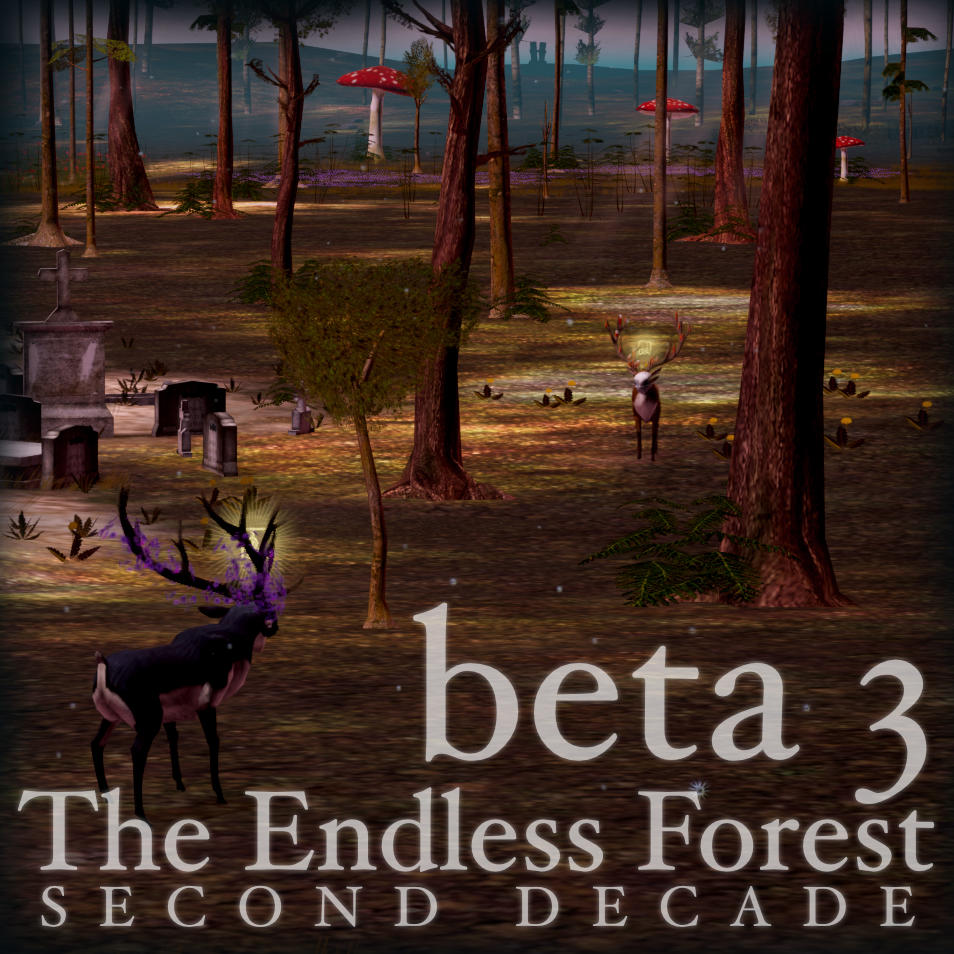
With any luck this will be the final closed beta version of the remake of The Endless Forest.
Some major networking errors were fixed in this release. Hopefully it all works well now. Because I really only half know what I’m doing or how Unreal Engine is supposed to do networking. So development is going through a bit of trial and error.
In this version a lot of small bugs were fixed, notably relating to some Abiogenesis features.
I also figured out what was making the previous build so huge: a completely unnecessary file over a Gigabyte in size! Each time I build the game, the process is different, even when I use the exact same version of the engine. The old way didn’t work anymore but the new way is fairly smooth, except for the hours that Visual Studio takes to compile things. I have to reserve the better part of a week just to make a build.
A download link has been sent to all backers. Thank you for your support!
Even though it feels like I spent most of my time exploring my new faith in 2022, I also got a lot of other things done. I released software, wrote books, started a new online identity, studied music and languages, traveled, interacted with my family and improved my health.
My ongoing remake of Tale of Tales’ first game, The Endless Forest, saw three releases this year: an alpha and two beta’s. That’s right: the game is in beta stage now, which means that, after five years of work, the remake is complete, barring bugs and errors.

I also created a new virtual reality piece called The Viriditas Chapel of Perpetual Adoration for our other ongoing project Cathedral-in-the-Clouds, the website of which I revamped for the occasion. And I launched my own personal website. I haven’t had a personal website since 1999, when Zuper! merged with Entropy8. New Twitter and Instagram accounts accompany this new online identity. Although I’m not very active on social media.
I made two books. Ex-Atheist is a series of confrontations of my thoughts on many subjects before and after my conversion to Catholicism. Some of these were published during advent. And Weekends in Gent is a book I made for my children with notes I had taken when they were young. I gave them a hard copy for Christmas.

In the beginning of 2022 I had serious doubts about playing music because I could not manage to free up the time required to reach the technical level I desired. But, also thanks to playing together with other people, I gradually accepted to just do what I can. This actually helped to improve my technique and culminated in a concert in January 2023. I also started studying a new instrument. Next to the viola da gamba, I’m trying to learn the cello. My guitars, however, have been a bit lonely this year.
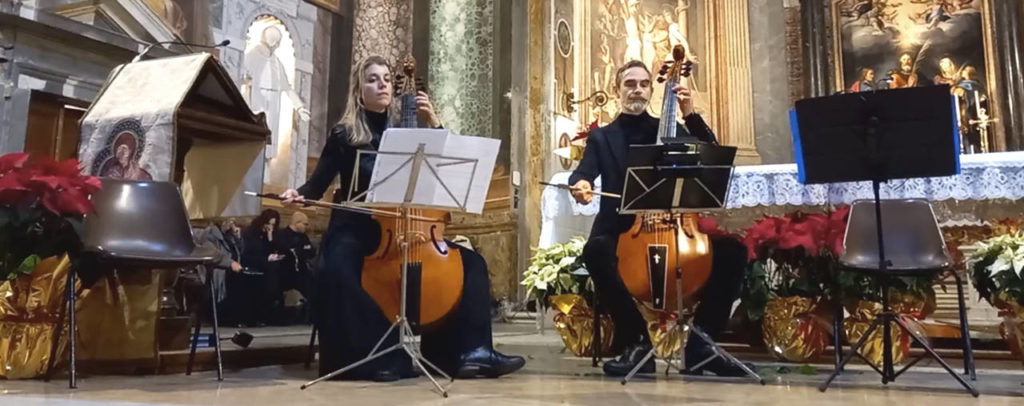
I continued to study Italian, especially through online video conversations with two teachers. But I also read a bunch of Italian books. And I have started learning Latin too, to help me figure out what all those texts mean on buildings here in Rome and said during mass.
In total I spent almost three months alone this year as my partner traveled for work. On some of these occasions I visited my home country of Belgium to see my family. But we also traveled to Belgium together (for Christmas), and to Venice, Palermo, Firenze and even the nearby Eur, which we had never seen in person. All but one of these trips were made by train, which can be quite an adventure!

My daughter visited us in Rome in the beginning of the year. And we swapped houses with her mother in the summer. During an unexpected trip to Belgium because of a death in the family, I had the pleasant experience of reconnecting with several cousins. My son caught Covid on his birthday, my mother in summer and I soon after, in spite of three vaccinations. Hopefully that’s over now.

I continued Alexander technique lessons, this year finally without a face mask. Next to not smoking, not drinking alcohol and eating very little meat, this year I have stopped drinking coffee and quit watching pornography. I did manage to get a nasty cut in my thumb after it got caught between the front door and its frame. Going to bed early, getting up early and napping in the afternoon has been the perfect rhythm for me that I will continue in 2023.
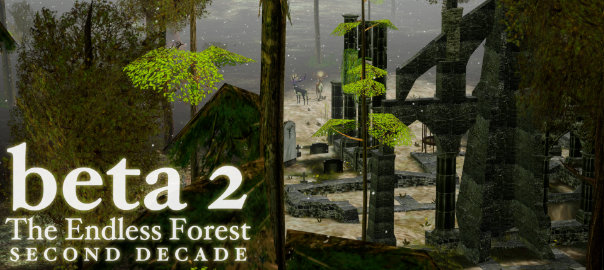
I spent all week on creating a build of the second beta version of the remake of The Endless Forest. It’s a complicated process because Unreal Engine only allows the building of a dedicated server program through a custom version of the engine built from source downloaded from a GitHub repository and a C++ based project, rather then one based on Blueprints, the visual programming language that is the main reason why I use this technology at all. The new version 5.0 of Unreal Engine seems to have made this process even more complicated and unpredictable. Following the directions failed but through trial-and-error juggling with many gigabytes of data I finally ended up with a software package that works. The resulting program is twice the size of the previous release built in Unreal version 4 (and 10 times the size of the original game which is exactly the same) and requires an up-to-date graphics driver and a recent version of Visual C++ runtime (included with the download).
Anyway, I’m extremely pleased with this build. We’re getting very close to a final release. Fingers crossed!
If you are a backer, you should have received a download link. If not, please let me know.
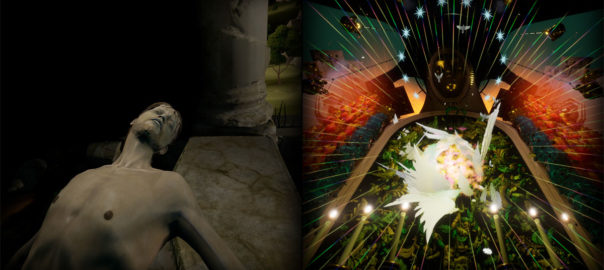
The Viriditas Chapel of Perpetual Adoration is not the first of my projects to deal with Christianity. In fact, a long thread throughout my creative career connects various references to Christianity, culminating in the ongoing production of Cathedral-in-the-Clouds. When the fundraising for that project started, I made sure that people realized that I was not a believer but instead interested in Christianity from an aesthetic and cultural point of view. Seven years later I can no longer claim the same.
The Viriditas Chapel of Perpetual Adoration is my first work of art as a Christian. Twenty three days after the release of Compassie, on Silent Saturday 2021, I heard God’s voice for the very first time and my life changed radically as a result.
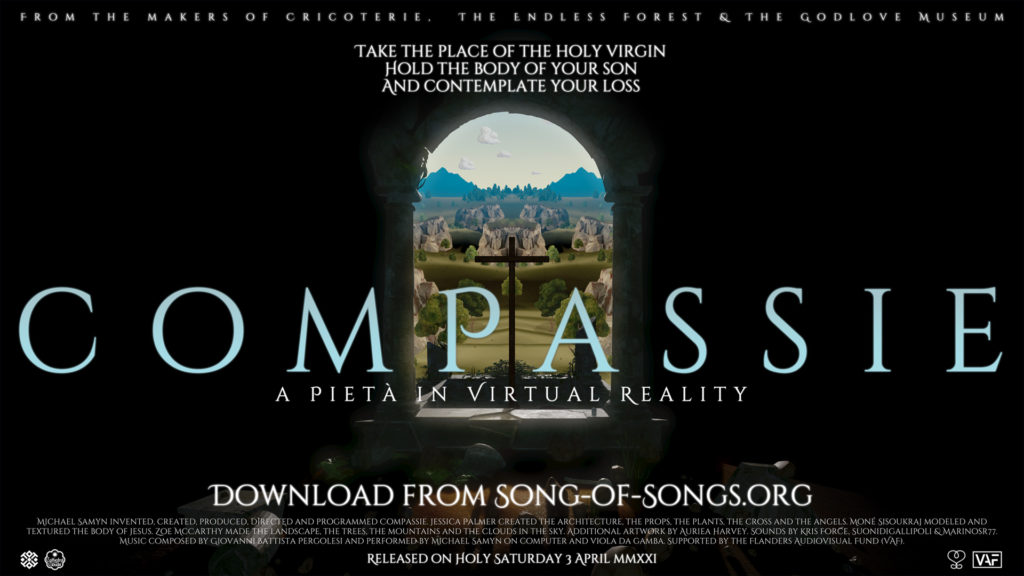
Compassie was a piece about sadness. It’s the classic pietà scene in which the Holy Virgin holds the dead body of her executed son. In virtual reality, you take her place. In front of you there is an ocean of darkness. Behind you a luscious landscape that forms the backdrop of a cross floating in mid air held somewhat ridiculously by four cherubs. He has risen! We are saved! But you turn back around and stare into the dark. Your son is dead. You are inconsolable.
I enjoyed how Compassie gave me a place where I could be sad. I remember enjoying how the VR goggles would hide my tears. I felt safe to let go in there, to silently endlessly cry about the sadness of life. I was certainly having personal problems at the time. But there was also the quite obviously desperate state of the world. Between the political polarization of society and the ecological crisis, I couldn’t see much hope.
Compassie was my tribute to this state of desperation. Christ became the symbol for the solution that everyone knows exists. But we killed Him, or we ignored Him and the promise made through His sacrifice. We know what a beautiful world looks like (just turn around!), we even know what it would take to get there (just turn around!). But somehow we find ourselves incapable of choosing that road and following it. We are stuck. Indulging in our misery. Too prideful to believe.
In hindsight, through the lens of my Christian faith, it is quite clear to see how Compassie was a subconscious “cry for help”. I was balancing on the edge of an abyss with nowhere to go that didn’t lead to destruction. I was ready for God. But I did not know that then. Until 23 days later.
For me, The Viriditas Chapel of Perpetual Adoration expresses quite well how my new found faith makes me feel. Astounded by a beauty that borders on the surreal but remains framed within a long tradition. I feel loved, I am grateful, I bow down in awe for the glory of God. It feel lightheaded with joy. I am becoming myself, the one He created for Himself. Like millions of others that have now become my kin. And then with all that splendor in my heart, the lights go out. And I find myself alone with Him. His body and blood, soul and divinity, embedded in a simple disk of bread, exposed on the altar. In the dark of my closed eyes I smell the incense, I feel His warm hands around my heart, the stubble on his cheeks catching the tears on mine as he embraces me and whispers His breath of life into all of me.
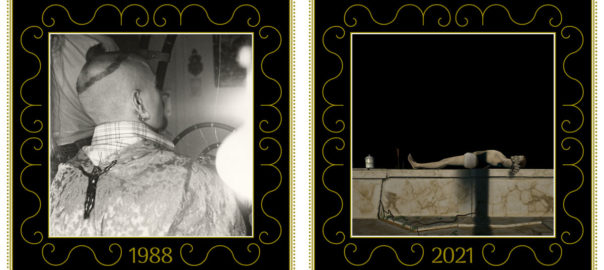
The Viriditas Chapel of Perpetual Adoration is the first work of art that I have created as a Christian. But this is far from the first time Christianity inspired me. In fact, the theme seems to have followed me throughout my creative life. God has been tirelessly knocking on that door and I kept wondering “What on earth is that noise?”
I grew up in an atheist household but I attended catholic schools. Hence my familiarity with Christian narratives. I have also long preferred old art. As a result Christian themes and iconography were no stranger to me. And as a designer of immersive spaces, I was drawn to churches for inspiration. I even regularly attended mass simply for the experience, to “see the machine performing the function it had been designed for.” But I did not believe.

1988 As a teenager I made clothes for myself. On one of my jackets I had sewn a bronze crucifix found at a flea market. But I did not believe.
1992 Right after school I created lots of art objects. I often used imagery from mass media and advertising. For one piece I mounted the logo of a brand of toilet paper in gold on a piece of black cardboard shaped like a baroque frame. The logo was a lamb. But I did not believe.
1995 In the early days of the web there had been a bug in the Netscape browser that allowed defining the body tag more than once. Thanks to the slow speed of modems this could be used to create animations that were otherwise not yet possible. When that feature was removed I created a web site called The Church of the Multiple Body Tag in protest. It referenced the choice between Jesus and Barabbas and the number of the beast. But I did not believe.
1995 In my first net.art piece called Home I made a sort of crucifix of a framed portrait of Kate Moss, two guns for hands and an electrical socket for feet on a wallpaper background. And only now, almost 30 years later, I discover that in that image, the model is wearing a necklace with a cross. But back then, I did not believe.
1996 My last net.art piece with Group Z, Belgium was called I confess. It was an online confessional with a game interface that forced you to admit all the sins you had committed as an artist. But I did not believe.
1997 In the early web days I was involved in several collaborative projects. One of them was on the hell.com domain for which I created the web interface. But I did not believe.
1997 The website collaboration with Olia Lialina started when she said her plane had crashed and she was writing from paradise. So we named the site Heaven & Hell, after the internet connection we discovered between the two. But I did not believe.

1999 When I met the love of my life we were separated by an ocean. We started creating together the day after. We were so overwhelmed by our experience that we reached for the grandest thing we could think of to express our love in the wires: the Pentateuch. Our web site unfolded a love story inspired by the first five books of the Bible. We called the whole thing The Godlove Museum. But I did not believe.
1999 Genesis was about two souls meeting online. Our relationship was both amorous and creative. We represented ourselves as saints, used baroque ornaments and sacred music. But I did not believe.
1999 When farao let Auriea go after several dramatic plagues, we made a website called Exodus. But I did not believe.
2000 When dealing with immigration laws and learning the customs of a new land, we made a chapter of The Godlove Museum inspired by the Bible book of Leviticus. But I did not believe.

2001 In our first interactive 3D piece, Eden.Garden, we used scans of our own bodies to represent Adam and Eve in a Garden of Eden generated from the code from any web page. Genesis was quoted directly. But I did not believe.
2001 In preparation for our first experiments with 3D, Auriea and I had scanned ourselves kissing. With The Kiss we created an immersive environment inside of the mesh of our entwined bodies that shared one heart that was shaped like a cross. But I did not believe.
2001 We called a small web project Per omnia saecula saeculorum, referencing a well known trinitarian doxology, with music from Handel’s Messiah. But I did not believe.
2002 The attack by US president Bush on Afghanistan was accompanied by rhetoric that seemed to come straight from the Old Testament. Simultaneously Auriea and I realized how different our cultures really were. We mixed quotes from Bible and president and even Jesus made an appearance in Numbers. But I did not believe.

2003 Our first videogame creation attempt, simply called 8, was inspired by a fairy tale, not a biblical text. I did include a chapel in my design for the palace of Sleeping Beauty. And the music we had chosen before working with Gerry De Mol was Pergolesi’s Stabat Mater. But I did not believe.
2005 When we figured out how to create and release a game, we made one in which deer would have glowing signs between their antlers, as in the legend of the conversion of Saint Hubert. At the launch of the project in the former abbey of Ename online players would convert visitors of the exhibition. And the central feature of this first phase of The Endless Forest was the ruin of a church. But I did not believe.
2006 Long after the previous chapter, when we had already given up on the web as an artistic medium, we created the last part of The Godlove Museum, Deuteronomy, in which we remixed the previous parts with Bible quotes about rules and regulations to express the sadness of not being able to enter the promised land. But I did not believe.
2008 In The Graveyard you play an old lady who visits a cemetery and listens to a song. It was inspired by my memories of the peaceful combination of solemn graves and lively nature in the cemetery of the small town where I spent my adolescent years. And by my grandmother who was still alive at the time and deeply catholic. I was profoundly struck by the cheerfulness with which she expressed her desire to join her husband who had died shortly before. But I did not believe.
2009 Fatale tells the story of the execution of John the Baptist. You play his ghost in his final night on earth, free to contemplate the love of Salome imagined by Oscar Wilde. Another biblical story. But I did not believe.
2010 When the first iPhone came out we created a Memento Mori for it the name of which, Vanitas, referred directly to the biblical basis of the concept from Ecclesiastes: “Vanitas vanitatum et omnia vanitas.” But I did not believe.

2011 During a research project called Cncntric I explored my interest in sacred architecture and medieval cosmology. I was mesmerized by how the architecture of a church would lead the visitor from the square that represents earth to the circle that represents heaven. And the geocentric conception of the universe, while disproven by Copernicus, still made a lot of spiritual sense. I love the idea of our planet floating in the embrace of ever expanding spheres and finally by God Himself. But I did not believe.
2013 We named Luxuria Superbia, a game the simulates sexual pleasure in an abstract and playful way, after the Latin words for two mortal sins: lust and pride. But I did not believe.
2015 Sunset takes place in San Bavón, the capital of an imaginary South-American country. For couleur locale, the dates in the game were accompanied by the mention of the Christian saint or feast of that day. But I did not believe.
2016 LOCK was a simple game structured along a gigantic geocentric universe. The name was an abbreviation of Loci Omnes Caelesistis Kyries which means something like “All Places of the Heavenly Lord”. But I did not believe.

2016 Liberated from the pressure of making commercial videogames, I found myself free to explore my life-long passion for Christian iconography en symbolism in old art and architecture. This culminated in a giant umbrella project called Cathedral-in-the-Clouds. I wanted to create opportunities for contemplation inspired by Christian narratives that I felt should be considered equally valuable to modern culture as Greco-Roman mythology. Backed by a successful crowdsourcing campaign and inspired by visits to numerous cathedrals in Belgium, France, Italy, Spain and Poland we created a prototype for a virtual reality cathedral. And the project even lead me to leave my country and move to Rome, around the corner of the Vatican of all places. But I did not believe.
2018 Cricoterie is a Virtual Reality program inspired by the Theater of Death of Polish theater make Tadeusz Kantor. As such it addressed the theme of religion and featured crosses and a priest. I relished the opportunity to deal with completely serious subject matter. But did not believe.
2021 After several rejected proposals for Christian themed dioramas -which turned out to be the most controversial subject of my already somewhat defiant career- including a tribute to Saint Ambrose, a chapel for Saint Anthony and a virtual sculpture of Adam and Eve, I managed to create a pietà in Virtual Reality. In Compassie I have the user take the place of the Holy Virgin sitting at the bottom of the cross with the dead body of her son on her lap. But I did not believe.
Michael Samyn, Rome, 14 October 2022.